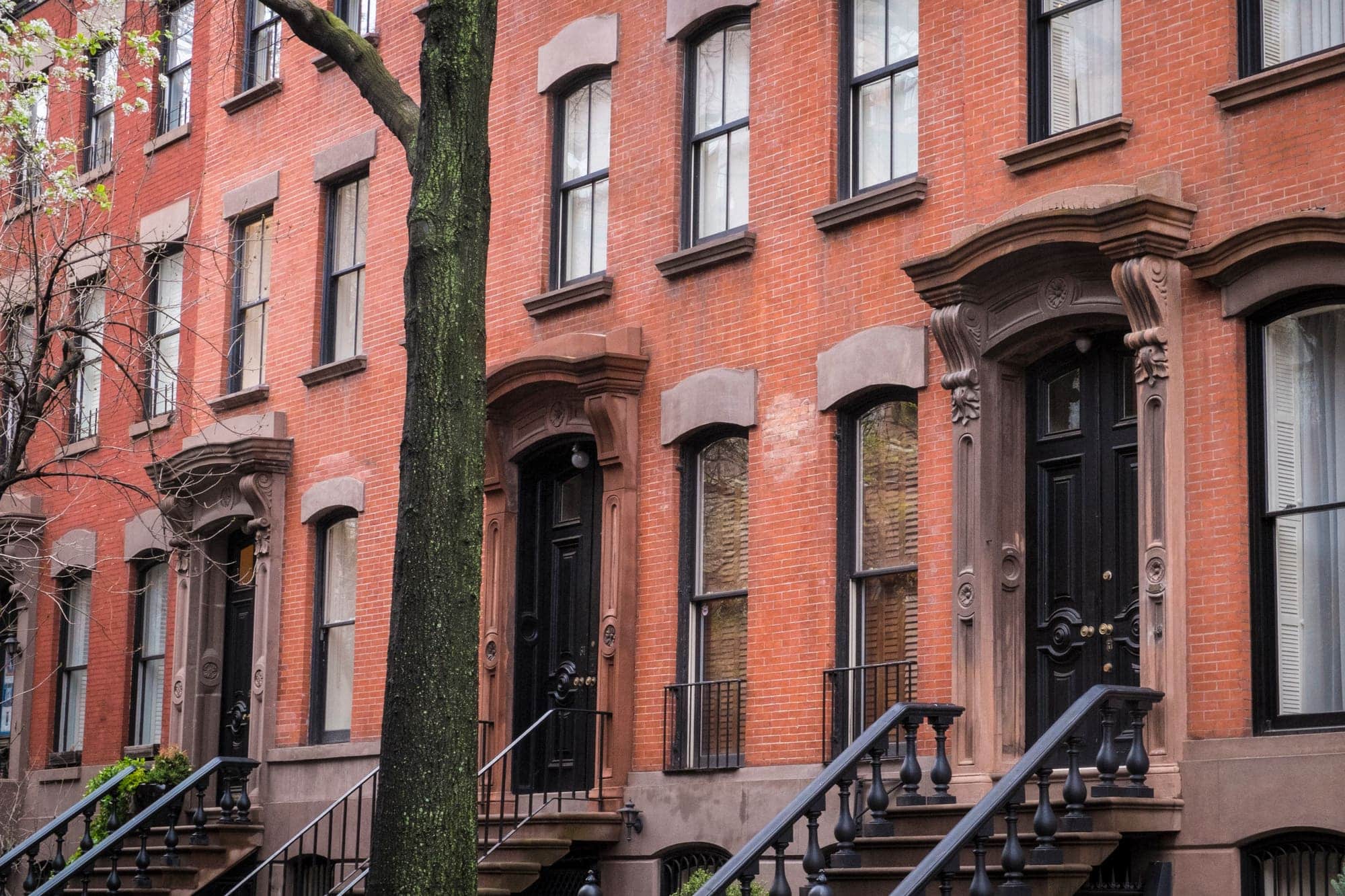If you’re searching for a new home or planning to invest in real estate, chances are you’ve heard of “brownstones.” These classic and attractive structures have been much sought after due to their special character, prime locations, and investment potential.
In this guide, we’ll answer the question “what is a brownstone?” explore its defining features, its advantages, and offer tips for finding your dream brownstone property. So let’s dive into the fascinating world of these architectural gems.
What Is a Brownstone?

A brownstone is a multi-story attached building made of brick or sandstone and is found primarily in historic urban neighborhoods. They are characterized by their elegant brownstone facades and charming Italianate details, which make them stand out from other types of residential properties.
The moniker “brownstone” is derived from the building material used to construct the row houses during the 19th Century. They offered up a more inexpensive alternative to limestone and marble, giving a burgeoning middle-class access to a standard of living otherwise unaffordable. Despite that, brownstones were often the preserve of the wealthiest, from industrialists to bankers and shipping magnates.
By the 20th Century, brownstones fell out of favor, leading to decay and disrepair. In fact, for a time, brownstones plummeted in value and could be bought at bargain prices.
However, they experienced a revival in the 1980s, with middle-class homebuyers investing in them. Today, they remain highly popular and command prices in the millions. One example, a five-story mansion in Brooklyn Heights, sold for $25 million in 2021.
Key Characteristics of a Brownstone
A true brownstone is not just defined by the material used in its construction but also by its architectural features and location.

Architecture
Brownstones are made of brick or sandstone, often featuring decorative elements such as cornices and balustrades. Their narrow, rectangular shape with a stoop leading to the entrance adds to their charm. Large, double-hung windows with wooden frames provide ample natural light inside these homes. In addition, brownstones often have the following characteristics:
- High ceilings and tall windows for an open and spacious feel
- A distinct brown color reflective of the specific building material they are made out of
- Detailed moldings and woodwork throughout the interior
- Original fireplaces made from marble or cast iron
- Spiral staircases connecting different levels within the home
Today, these elements have elevated the brownstone as an enduring symbol of major cities in northeast architecture, particularly in New York.
Location
Brownstones are located in historic urban neighborhoods. Traditionally, they were extensively used by the affluent. During the 20th Century, many brownstones fell into disrepair, especially in Crown Heights and Harlem.
However, with time, they became increasingly sought after, thanks to their association with upmarket, close-knit communities filled with tree-lined streets. These upscale city streets offer convenient access to public transportation, parks, shops, restaurants, and schools.
Communities that feature brownstone properties are now regarded as desirable neighborhoods with a unique, historic charm.
Amenities
Many brownstone buildings have been converted into multi-unit dwellings, making them convenient for renters or homeowners who desire extra living space.
Some properties feature outdoor areas such as gardens, balconies, or roof decks, providing brownstone owners with a calm oasis amid the bustling cityscape.
Material
A brownstone house is primarily made of brick or sandstone, giving them a distinctive appearance.
Stone construction also provides insulation, keeping the home warm in the winter and cool in the summer. However, as with any historic property, maintenance is an important consideration.
In particular, homeowners need to be mindful of warning signs of disrepair, like leaks, brownstone flaking called “spall,” and plumbing issues. Skilled stone workers are often necessary to restore brownhouses and address serious issues with their construction.
Size
The square footage of a brownstone can vary, from cozy studios to spacious apartments or townhouses with a parlor floor. Depending on the original design and adaptation, it may have two to five floors and be a single-family home or a multi-unit building.
Advantages of Owning a Brownstone House

Owning a brownstone offers several advantages to homeowners, including:
Investment Potential
Historic properties like brownstones often appreciate in value over time, making them a solid investment choice for homebuyers. Brownstones, in particular, benefit from their attractive design that helps them stand out from more modern options.
Moreover, in New York, they are often situated in fashionable neighborhoods like the Upper East Side. While that often comes with a premium price, demand is so high that a brownstone’s value can still deliver a profit down the line.
Character and Charm
Brownstones boast unique architectural details such as ornate cornices, balustrades, large windows with wooden frames, and stoops leading up to the entrance. These features give each a distinct personality, appealing to those who value the individuality and heritage of a home.
Community and Amenities
Some of the community and amenities associated with brownstones include:
- Vibrant culture: Brownstones are located in well-established urban areas with rich history and culture. They are typically within walking distance or a short commute from shopping centers, parks, museums, and galleries.
- Sense of community: As many are row houses, brownstones have long fostered a sense of community among neighborhoods.
- Amenities & services: Many neighborhoods featuring brownstones offer reliable public transportation, proximity to schools, grocery stores, and recreational facilities.
By their nature, brownstone communities are often some of the most desirable in the country. They are typically highly walkable, boasting well-maintained sidewalks and tree-lined streets. In that context, they represent one of the best ways to experience city living without the hustle and bustle found in skyscrapers or modern apartment complexes.
Tips for Finding a Brownstone
When considering purchasing a brownstone house, being well-prepared and informed is essential. Here are some helpful tips to guide you through the process:
Research the Neighborhood
Search for properties in neighborhoods known for their historic charm and architectural beauty. Look into local amenities, schools, parks, and transportation options to ensure your potential new home is in an area that suits your lifestyle.
Check for Zoning Restrictions
Zoning restrictions can impact what renovations or modifications you can make to your brownstone property. Consult local agents or real estate attorneys with extensive knowledge of zoning laws in various areas and can help guide you through any limitations.
Consider the Condition and Renovations Needed
It is vital to evaluate whether the brownstone requires significant updates or if its current condition meets your needs. You can also determine if any historical preservation guidelines apply to the property; these may limit certain changes or require specific materials when renovating.
Get a Thorough Inspection
A professional inspection is crucial when buying any home but especially important with older properties like brownstones. Inspectors will assess structural integrity, electrical systems, plumbing issues, and pest infestations to ensure no surprises arise after purchase completion.
Key Takeaways
Understanding the question of “What is a brownstone” is the first step to living or investing in one of these historic buildings. Their elegant design and location in sought-after urban neighborhoods symbolize classic urban living.
If you are looking to buy a brownstone, consider working with a qualified and experienced real estate agent who can guide you through the process from start to finish. ensuring that you find the perfect brownstone property that suits your lifestyle, needs, and budget.
Contact a local eXp agent today for expert guidance and access to exclusive listings. You can also sign up to get alerts for new property listings when they come on the market.
FAQs
Here are some of the frequently asked questions about brownstones:
What makes a house a brownstone?
Brownstones are known for being unique but there are key elements synonymous with this type of building, such as:
- Brown, sandstone facade
- Narrow, rectangular shape with stoop entrance
- Ornate architectural details
- Masonry construction
- Tall ceilings and large windows
These elements contribute to their enduring appeal as desirable urban residences.
What’s the difference between a townhouse and a brownstone?
A townhouse is a residential building generally covering the entire width of a city block, with individual dwellings stacked vertically. Conversely, a brownstone is a multi-story attached building made of brick or sandstone found primarily in historic urban neighborhoods, featuring unique architectural details.
Why are brownstones so desirable?
Brownstones offer a unique blend of historic charm, distinctive architecture, and prime location in vibrant urban neighborhoods. Their ornate details, masonry construction, and spacious interiors make them popular with homeowners and renters.
The communities surrounding brownstone properties provide a range of amenities and services, from shopping centers and recreational facilities to varied schools and transportation options. Moreover, their investment potential makes them attractive to those looking to develop a profitable real estate portfolio.
Do New York brownstones have backyards?
While not all New York brownstones have backyards due to limited spaces, many have outdoor spaces like gardens, patios, or roof decks. Some renovated properties have a rear extension that contains a backyard or landscaped garden.
What cities have the most brownstones?
Brownstones are most commonly found in the urban areas of the Northeastern region of the United States, with New York City being the most prominent. Other cities with notable brownstone neighborhoods include Boston, Philadelphia, Baltimore, and Washington, D.C.
Do brownstones have elevators?
Not all brownstones have elevators, as they were originally designed as walk-up buildings. However, some renovated or converted brownstones have added elevator access for easier living.
Do brownstones have attics?
It depends on the design and construction of the brownstone. As older buildings, their attics may not be suitable for certain uses due to potential structural concerns or insulation issues. Still, some properties have converted their attics into additional living space, while others may use it for storage.
Do brownstones have multiple units?
Yes, but many brownstones are still single-family homes, making them a rare and valuable find in a competitive real estate market. However, the number of units depends on the building’s design and renovation, with some brownstones housing two to five units.





